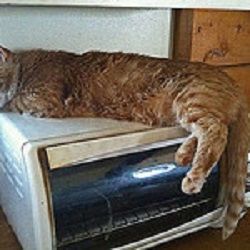
Cats purr using the laryngeal and diaphragmatic muscles. They purr with a frequency of between 25 and 150 Hertz, a frequency range which, according to investigations, promotes healing and higher bone density. Although a cat’s purr is often associated with contentment, many cats purr during mores stressful times, such as during visits to the vet. Thus, it is unclear exactly when or how cats purr, prompting further research into this phenomenon.
It is also posited that because cats have adapted to conserve energy by sleeping for long periods of time, purring might be a way to stimulate the body without using much energy, alleviating dysplasia and other conditions often seen in dogs.
Fun Fact: The beneficial effect of purring on bone density may be a useful fact for astronauts in space, for whom loss of bone and muscle density in zero gravity is a major concern.
Works cited: Lyons, Leslie. “Why do cats purr?” Scientific American. April 3 2006. Web. 8 March 2014.
<http://www.scientificamerican.com/article/why-do-cats-purr/>
